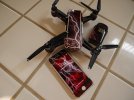I put my brand new MM in the Cinema mode, installed the propeller guards, and took off in my bedroom. Heart beating with excitement, I slowly maneuvered it around to get the feel for it. When I got confident enough, I have flown it out of the bedroom, and within minutes crashed it down the wall. Twice. In exactly the same way. Here’s how.
At one point, I moved it backwards and the propeller guards touched the wall, and the MM “leaned back” into the wall so that the front propellers were ever so slightly higher than the back propellers. I knew enough not to try to touch it. (I like my fingers; also I know it has sensors on the bottom, and it would move up and away from my hand if I approach it from below.) So my natural instincts were to fly it forward, away from the wall... Crash.
At this point let me reconstruct what happened. To fly forward, a drone increases the speed of the back propellers. That way it, leans forward and moves horizontally. But in this case, the back propeller guard is “hinged” at the wall. The more I pushed the joystick forward, the harder the back propeller worked which only made it lean back against the wall even more. The nose kept going up up until at some point my MM just slid down the wall and crashed. Thankfully, it was OK; the propeller guards really helped.
So here is how I think I could have gotten out of that situation. (With all the benefits of the hindsight and cooler head.) First, the drone is leaning back against the wall, nose up. If I was to first slowly pull it down a bit (left joystick down) and then also push it forward, it would bring its nose down enough so that the increase in the back propellers speed would detach it from the wall. Naturally, I haven’t tried this, but I would do that if I was to find myself in the same situation again.
I’ll be curious to hear from others, too. Any other ideas to resolve this situation?
At one point, I moved it backwards and the propeller guards touched the wall, and the MM “leaned back” into the wall so that the front propellers were ever so slightly higher than the back propellers. I knew enough not to try to touch it. (I like my fingers; also I know it has sensors on the bottom, and it would move up and away from my hand if I approach it from below.) So my natural instincts were to fly it forward, away from the wall... Crash.
At this point let me reconstruct what happened. To fly forward, a drone increases the speed of the back propellers. That way it, leans forward and moves horizontally. But in this case, the back propeller guard is “hinged” at the wall. The more I pushed the joystick forward, the harder the back propeller worked which only made it lean back against the wall even more. The nose kept going up up until at some point my MM just slid down the wall and crashed. Thankfully, it was OK; the propeller guards really helped.
So here is how I think I could have gotten out of that situation. (With all the benefits of the hindsight and cooler head.) First, the drone is leaning back against the wall, nose up. If I was to first slowly pull it down a bit (left joystick down) and then also push it forward, it would bring its nose down enough so that the increase in the back propellers speed would detach it from the wall. Naturally, I haven’t tried this, but I would do that if I was to find myself in the same situation again.
I’ll be curious to hear from others, too. Any other ideas to resolve this situation?











